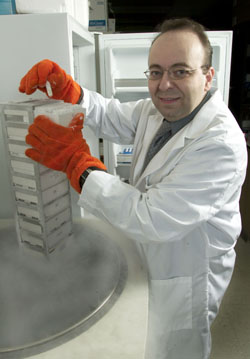
Derya Unutmaz, M.D., removes from the freezer a vial containing a subpopulation of white blood cells that seem to play an important role in HIV infection./Neil Brake
Missing immune system ‘brakes’ may lead to HIV progression
A master regulatory switch that can suppress immune responses plays an important role in HIV infection, researchers at Vanderbilt University Medical Center reported this week.
The switch is a gene called Foxp3, which encodes a transcription factor required for the development of “T regulatory cells (Treg).”
These cells, which make up only about 2 percent of all white blood cells, can suppress (regulate) the body’s immune response in order to keep it from getting out of control.
Treg cells are highly vulnerable to attack by the human immunodeficiency virus (HIV), the Vanderbilt researchers report in the July issue of PLoS Biology, an online journal published by the Public Library of Science (www.plosbiology.org). In about half of the 24 HIV-infected patients in the study, these cells appeared to be depleted.
The loss of Treg cells may be one way the virus gains a foothold in the body, says Derya Unutmaz, M.D., assistant professor of Microbiology and Immunology, and the paper’s senior author.
When the “brakes” on the immune response are removed, the immune response revs up, or becomes “hyperactivated.” Ordinarily, a “revved up” immune system would fight off the microbial invasion.
But HIV is different. The virus preferentially targets “helper” T cells, a subset of white blood cells that coordinates the immune response. The activation of helper T cells — resulting from the loss of “brakes” (Treg cells) — actually may provide more targets for HIV, and aid the gradual dismantling of the entire immune system by the virus, he said.
Treg cells are difficult to study because they are so few in number. Unutmaz and his colleagues found they could turn naïve human T cells, which are not yet primed to recognize a specific target, into Treg cells in the laboratory by slipping Foxp3 into them. “That allowed us to generate millions of cells,” Unutmaz said.
The Foxp3 gene encodes a transcription factor, a protein that binds to DNA and which is thought to be a critical control switch for immune system regulation. Mutations in the gene are associated in animals and humans with lethal autoimmune disorders, in which the immune system attacks body tissues.
The Vanderbilt researchers found that once T cells were transformed into Treg cells, they became more susceptible to HIV infection. This suggests that expression of the FoxP3 gene changed “the milieu of the cell” to make it more vulnerable to the virus.
“When the virus enters the cell, it encounters lots of host factors,” Unutmaz explained. “Some of these are factors that stop the virus. Others ‘up’ the virus. Somehow FoxP3 is either down-regulating these suppressor factors or up-regulating factors that help the virus.”
While this study does not conclusively prove that depletion of Treg cells unleashes a hyperactivated immune response, “we are suggesting that this could be a potential mechanism that could explain this hyperactivation, which we think leads to HIV pathogenesis,” he said.
On the other hand, an over supply of Treg cells (too much “brake”) could suppress other parts of the immune system that attack and destroy HIV-infected cells. Tipping the delicate balance of immune regulation either way “could have a profound impact on anti-HIV immune responses and the pathogenesis of the infection,” the authors concluded.
The ability to produce almost unlimited quantities of Treg cells in the laboratory should help researchers better understand the role that these cells play in immune suppression and the development of AIDS.
Since Treg cells share common surface markers with other activated T cells, it is difficult to pick them out of the “pack.” Production of large numbers of the cells may help scientists find new surface markers that are unique to Treg cells and which could be used to more accurately identify and quantify them.
In addition, the ability to genetically “reprogram” T cells into Treg cells “could have profound implications for preventing graft-versus-host disease,” the authors write. The disorder, which results from an attack by transplanted bone marrow on the tissues of the recipient, causes complications that can be potentially life threatening.
To suppress this attack on recipient tissues, Unutmaz and his colleagues are conducting animal studies of a modified, harmless form of HIV — called a lentiviral vector — to “reprogram” transplanted T cells into Treg cells.
In collaboration with Friedrich G. Schuening, M.D., Ingram Professor of Cancer Research and professor of Medicine, and Adetola Kassim, M.D., assistant professor of Medicine, the researchers remove pieces of the HIV genome so it is no longer infectious, stitch in the Foxp3 gene, and use the modified virus to “shuttle” the gene into the T cells.
“We’re really learning from the virus how the immune system works,” Unutmaz said. “We think some good will come out (of) HIV.”
Unutmaz’s co-authors on the paper, titled “HIV Infection of Naturally Occurring and Genetically Reprogrammed Human Regulatory T Cells,” are Kyra Oswald-Richter, Stacy M. Grill, Nikki Shariat, Mindy Leelawong, Mark S. Sundrud and David W. Haas, M.D.
The research was supported by a grant from the National Institutes of Health and by the Vanderbilt-Meharry Center for AIDS Research.













